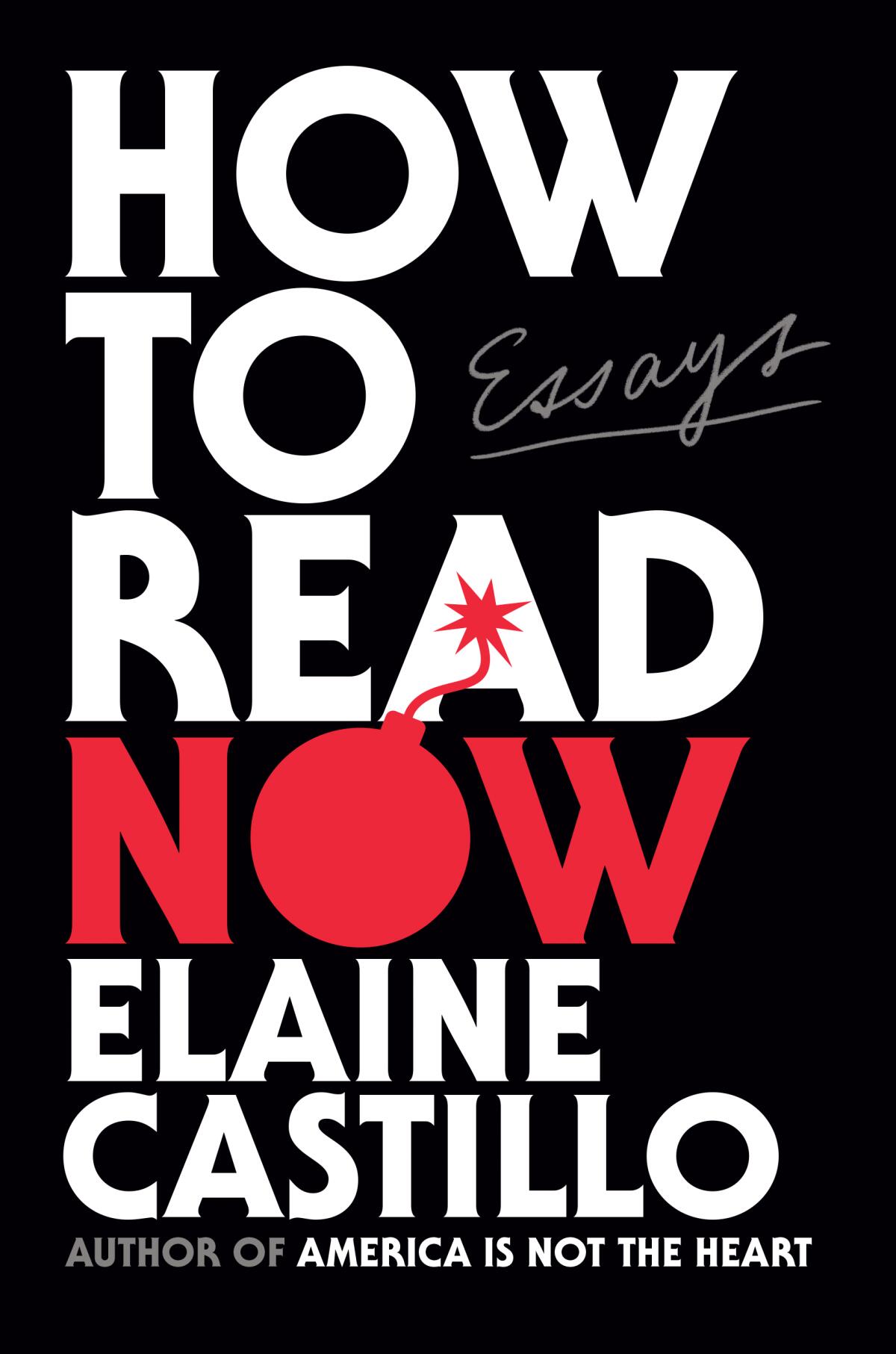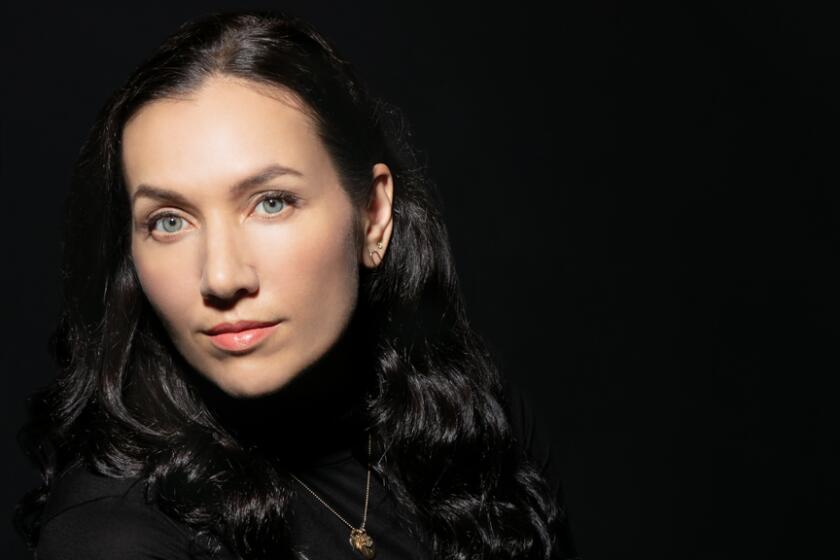What are books for? A novelist goes beyond the hot takes

- Share via
On the Shelf
How to Read Now: Essays
By Elaine Castillo
Viking: 352 pages, $27
If you buy books linked on our site, The Times may earn a commission from Bookshop.org, whose fees support independent bookstores.
Elaine Castillo’s “How to Read Now” begins with a section called “Author’s Note, or a Virgo Clarifies Things.” The title is a neat encapsulation of the book’s style: rigorous but still chatty, intellectual but not precious or academic about it.
In that author’s note, Castillo gives an overview of her intended audience. She’s writing not just for “the type of people who read books and attend literary festivals,” she hopes. “Books, as world-encompassing as they are, aren’t a destination,” she argues. “They’re a waypoint … one of the places we go to help us to become readers in the world.” Ultimately, she says, “I’m not just talking about how to read books now; I’m talking about how to read our world now.”
Castillo, in other words, isn’t merely interested in preaching to the choir that reading is important. She knows that — and hopes we do too. Instead, she’s asking us to investigate how and why we read: to pay attention to what information we’re ingesting and how we’ve been taught to interact with it. This is a particularly high-stakes argument right now, not just because of the recent uptick in book bans but also because the conversation between people who do read so often reduces book culture to hot takes and prepackaged talking points.
The introduction is helpful, because from there, “How to Read Now” proceeds at a breakneck pace. Each of the book’s eight essays burns bright and hot from start to finish. Castillo, who debuted with the novel “America Is Not the Heart,” is both fiercely intelligent and fiercely opinionated (that’s part of what she means by saying she’s a Virgo, for readers not versed in astrology). She tolerates no fools and takes no prisoners. In a representative excerpt from an essay titled “Reading Teaches Us Empathy, and Other Fictions,” Castillo compares asking writers of color to “produce a comment from the hot-take-jukebox on the latest [screw-up] perpetrated by the determinedly racist and tone-deaf publishing industry” to requesting that they “wipe a s— they did not take.”
Maggie Nelson, whose essays and poetry have changed the way we think about art, queerness and gender, talks about her timely new book, “On Freedom.”
“How to Read Now” is not for everybody, but if it is for you, it is clarifying and bracing. Castillo offers a full-throated critique of some of the literary world’s most insipid and self-serving ideas, as well as some thoughts on how to pursue reading not as an exercise in building one’s own personal storehouse of virtue but instead as part of an ongoing decolonialist — which is to say, fundamentally connected and connective — practice.

There are two main styles of reading that Castillo is interested in dismantling. One is the notion of “art for art’s sake,” which holds that art objects should be allowed to exist free of context, history or any kind of political analysis. Castillo retorts that any work worth admiring is strong enough to withstand criticism — whether aesthetic, cultural or political. “Acknowledging the truth of the colonialism and the slave trade in [Jane] Austen’s era is no vandalizing act of literary deletion,” she argues, “but an act of literary expansion and restoration, not to mention the barest concession to reality.”
That argument isn’t exactly brand-new; it extends back to the very first critics who ventured beyond formalism. But her second target complicates and enriches the book. There are those, she writes, for whom reading is not just necessarily but only political — intended to improve one’s self and standing rather than, as the writer Jia Tolentino put it in a 2020 interview, pursuing “the genuine pleasure of decentering themselves.” This viewpoint, in Castillo’s description, reduces art — all too frequently the art of marginalized people — into “a kind of ethical protein shake,” which will “somehow build the muscles in us that will help us see other people as human.” Its basic idea “makes a superficial kind of sense,” she allows, but it also “produces a superficial effect.”
So how should we read now? Castillo offers suggestions but no resolution. She is less interested in capital-A Answers — the stuff of, for example, the anti-racist reading guides of 2020 — and more excited by the opportunity to restore a multitude of voices and perspectives to the conversation so that we might find ourselves immersed in our texts rather than trying to maintain authority over them.
Being willing to see and speak about history, even when it is ugly, is what allows us to truly reach one another through fiction, Castillo argues. It is precisely by contextualizing artistic works — while also respecting their artistry — that we move past “relevant” portraits of some exoticized Other and toward understanding how our histories are intermingled and co-constructed. “We can only be each other’s people if we actually do the work of being each other’s people,” she writes: “looking our shared history in the face and really reading it.”
“White Magic,” Elissa Washuta’s collection of essays on culture, appropriation, ancestral pain and sobriety, feels more like a single, powerful piece.
She does, as promised, range beyond the page as well. The essay “Honor the Treaty” explores how public signage, statues and even ecology contribute to how we read our surroundings, helping us understand that they are not neutral but politically and historically charged. “Autobiography in Asian Film, or What We Talk About When We Talk About Representation” focuses, as its title suggests, on what it feels like to see and be echoed in characters on screen, and how those cinematic visions resonate in the world outside the darkened theater.
In any book with so many opinions, the reader is bound to disagree with some. There are moments when you almost wish Castillo would stop talking so you can get a word in edgewise. But then, that’s exactly what makes “How to Read Now” so rewarding: It’s not a lecture but one half of a conversation, less intent on issuing commands than on provoking responses.
In the book’s final essay, “The Children of Polyphemus,” Castillo writes movingly about how our notions of the civilized are constructed — and how much is cast aside by the barriers put up in the process. The stories we tell about who counts as human, as worthy of care, determine how we treat one another. “How do we hold ourselves accountable — the root of accountable meaning: how do we let the story of ourselves get told?” she asks. “To hold ourselves accountable … means that in our art, we bring to bear not our most powerful, authoritative, intelligent selves, but: our most particular, our most precarious, our most dependent selves.”
A book is nothing without a reader; this one is co-created by its recipients, re-created every time the page is turned anew. “How to Read Now” offers its audience the opportunity to look past the simplicity we’re all too often spoon-fed into order to restore ourselves to chaos and complexity — a way of seeing and reading that demands so much more of us but offers even more in return.
Romanoff is a writer and the author of several novels for young adults.
Memoirist Melissa Febos attacks the gender dynamics of the anti-personal-essay crowd in “Body Work: The Radical Power of Personal Narrative.”
More to Read
Sign up for our Book Club newsletter
Get the latest news, events and more from the Los Angeles Times Book Club, and help us get L.A. reading and talking.
You may occasionally receive promotional content from the Los Angeles Times.










